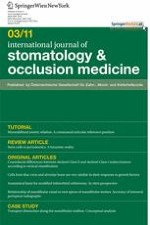Erschienen in:

01.11.2011 | original article
Craniofacial differences between skeletal Class II and skeletal Class I malocclusions according to vertical classification
verfasst von:
Ulas Oz, Meliha Rubenduz
Erschienen in:
international journal of stomatology & occlusion medicine
|
Ausgabe 3/2011
Einloggen, um Zugang zu erhalten
Abstract
Background
The aim of this study was to determine morphological differences among Class II, division 1 (Class II,1) subjects with different rotation models according to mandibular plane inclination and to compare these with normal subjects.
Methods
The study consisted of 132 subjects (99 Class II,1 and 33 Class I control group). The Class II,1 group included subjects who had ANB (point A-nasion-point B) angles greater than 4° with an overjet equal to or greater than 5 mm. Based on the SN/Go-Gn (cranial base anterior length/gonion-gnathion) angle, subjects were divided into three different rotation models as hypodivergent, normodivergent and hyperdivergent. Variance analysis (ANOVA) was used to assess the presence of differences between groups (p < 0.05).
Results
There was no statistical difference among the three groups in Class II,1 malocclusion according to upper face height (N-ANS), total mandibular size (Cd-Pg) and mandibular corpus size (Go-Gn) (p > 0.05). Although the ramus (Cd-Go) was significantly shorter in the Class II,1 hyperdivergent group (p < 0.05), the hypodivergent group had similar ramus heights compared with controls.
Conclusions
Class II groups showed a similar increase in the ANB angle in spite of a different vertical rotation type. This study concludes that future Class II studies should divide subjects into subgroups according to hypodivergent, neutral and hyperdivergent phenotypes.











